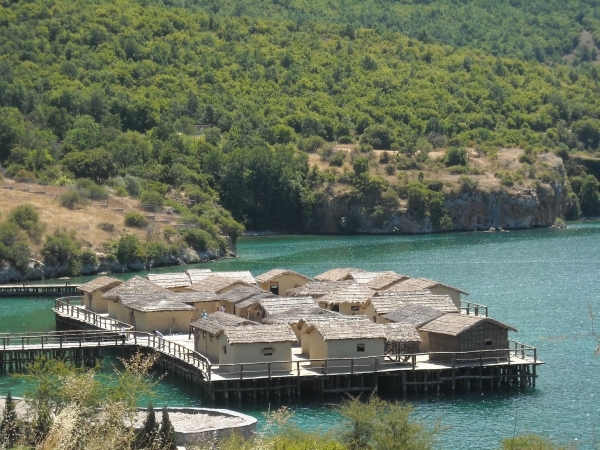The complex "Museum on Water" is located on Lake Ohrid by the
road from Ohrid to Sv. Naum. The complex is comprised of three
units:
- The Prehistoric pile dwelling settlement above the lake
waters
- The Roman castellum at the flattened plateau of the
"Gradište" hill
- The museum land access with infrastructure architecture

The Prehistoric lake pile dwelling settlement "Ploča
Mičov grad" in the Bay of the Bones
Represents a presumed reconstruction of a Prehistoric palafitte -
pile dwelling settlement from the Copper, Bronze and Iron Age,
flourishing at the end of Bronze and in Early Iron Age, i.e.
between 1200 and 600 B.C. The remains of the settlement are located
at the lake bottom, at a depth between 2.40 and 5.00 m. The
underwater archaeological research conweyed between 1997 and 2005
had revealed the positioning of 6000 wooden piles attached to the
lake bed, and most probably, during the existence of the
settlement, there must have been more than 10000 wooden piles
attached, which, in different prehistoric times, supported a wooden
platform. There had been at least 24 prehistoric houses made of
wooden materials, plastered with house platter and covered with
thatching and typha that were permanently functioning on the
platform. At the lake bottom have been discovered numerous whole
and fragmented vessels, discoid ceramic plates for fishing nets and
for weaving, stone axes, flint knifes, hand grinders for wheat and
numerous fragments of animal bones. The presumed reconstruction of
this prehistoric settlement was based on the disposition of the
preserved piles at the lake bed. In 2008, 1060 wooden piles had
been placed in the lake, and on the platform supported by them 8
houses were built. In 2010, 2286 piles had been attached at the
bottom and above the wooden platform additional 16 prehistoric
houses were erected. A total of 3346 piles had been attached in the
lake and a total of 24 prehistoric houses had been built above the
lake. Among them, 21 houses are rectangular, while 3 are round for
cult and ritual purposes of the settlers.
The Roman Castellum
Located on the flattened plateau of the "Gradište" hill. It
served for the stay of smaller auxiliary Roman troops, i.e. smaller
military units. It had been built with fortification walls and
towers in the 2nd century AD. In 2007-2008 there was a systematic
archaeological research performed, while in 2008
conservation/restoration and reconstruction activities were
undertaken. It covers a surface of 8280 m2.
The museum land access
A museum access building was built at the lake shore in 2008. It
hosts an exhibition of movable archaeological objects extracted and
excavated from the lake bed during the underwater archaeological
research between 1997 and 2005.
The cache
The cache (35 mm film canister) is hidden outside the museum
complex, in a small grove above the parking.
Remark on the cache maintenance: our friend Toni will help us to
maintain this cache.